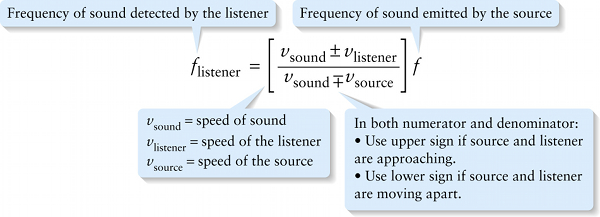The Doppler effect (13-35)
Question 1 of 4
Question
Frequency of sound detected by the listener
{"title":"Frequency of sound detected by the listener","description":"Correct!","type":"correct","color":"#99CCFF","code":"[{\"shape\":\"poly\",\"coords\":\"82,133\"},{\"shape\":\"rect\",\"coords\":\"10,16,12,16\"},{\"shape\":\"rect\",\"coords\":\"1,18,18,47\"}]"} {"title":"Frequency of sound emitted by the source","description":"Wrong","type":"incorrect","color":"#ffcc00","code":"[{\"shape\":\"rect\",\"coords\":\"289,17,302,49\"}]"} {"title":"In both numerator and denominator: • Use upper sign if source and listener are approaching. • Use lower sign if source and listener are moving apart.","description":"Incorrect","type":"incorrect","color":"#333300","code":"[{\"shape\":\"rect\",\"coords\":\"184,45,201,62\"}]"} {"title":"v sub sound = speed of sound, v sub listener = speed of the listener, v sub source = speed of the source","description":"Incorrect","type":"incorrect","color":"#000080","code":"[{\"shape\":\"rect\",\"coords\":\"96,0,284,69\"}]"}Review
We can determine the observed frequency as the source moves away from a stationary listener, as well as for the cases in which the listener moves relative to a stationary source. Here’s a single equation for the frequency heard by the listener no matter how the source and listener are moving:

